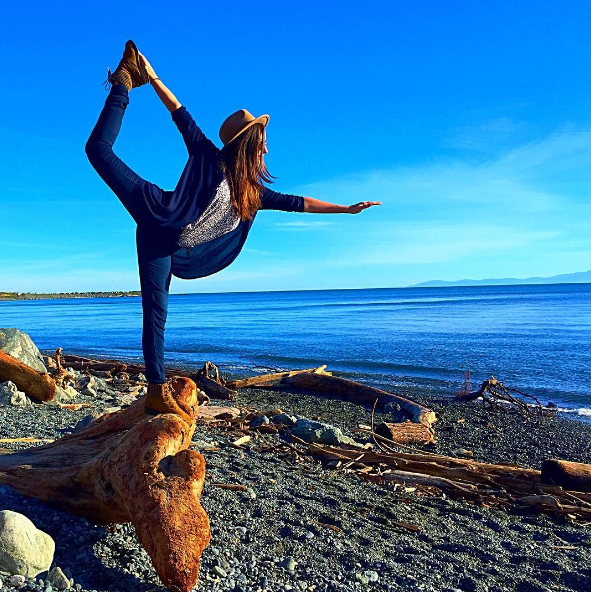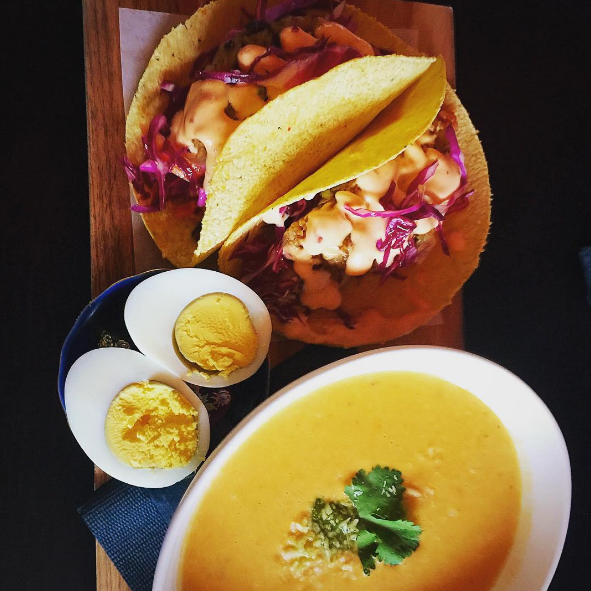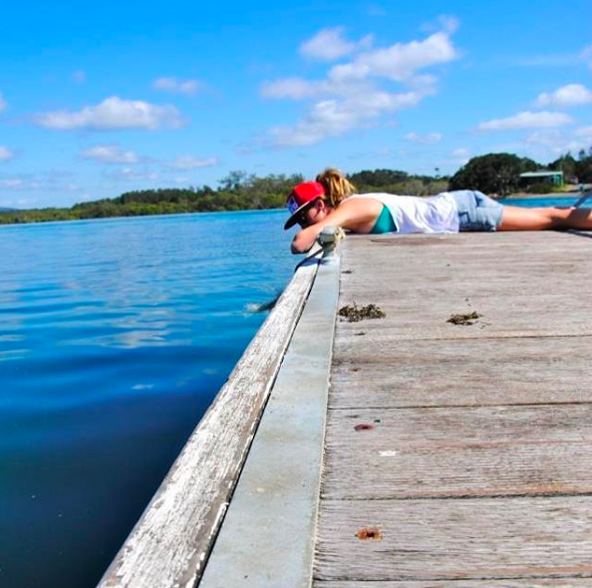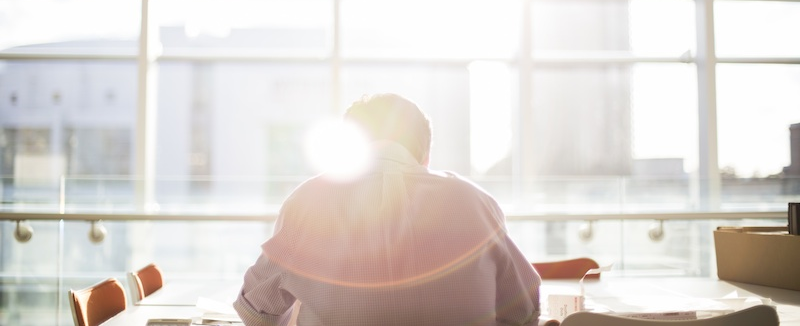
Aprivé Wellness Blog
3 things you should eat everyday & other wisdom with Amy Ritchie
It's been a while since I've shared wellness words with you, and it's all because I've settled into life as a Physiotherapist in Melbourne, Australia, after leading retreats in Bali. So now I'm all nestled in, here's an incredible interview with our friend holistic nutritionist Amy Ritchie who tell you why you can't hate yourself healthy, and other gems.
What is healthy eating?
This one is tricky. I think often we want to the know the 5 foods we need to eat all the time to be “healthy.” Because this is easy. The real work is looking at who we are as eaters.
We can’t talk about healthy eating, or achieve wellness, without addressing our relationship with food. You can't hate yourself into healthy! Choosing foods from a place of respect for your body rather than hate & restriction is healthy eating.
Enjoying a treat without experiencing shame afterwards is healthy eating.
Why are food pics and cooking shows taking over social media?
We’re visual & we have short attention spans. I love getting inspired by food shows & photos but it needs to leave the screen and get to your kitchen! It’s easy to feel like you’re making steps to being healthy by pinning recipes, but then never actually making them. Get inspired, find one good recipe and then make it! You can pin more later.
I also get curious as to how this plays into overeating. There’s a phase of digestion referred to as the cephalic phase. In this phase seeing, smelling and thinking about food begins the digestive processes in the body. You have a physical response to seeing pictures of food (salivating at a picture is a real thing!) So try to follow healthy food accounts and look before eating not before bed. It may actually be a good way to ramp up digestive function!
What are your 3 favourite things to make?
Eggs are a go to for me in the morning and lately I’ve been loving them scrambled with some raw garlic, turmeric, cherry tomatoes & arugula (I think you call it rocket).
I’m also on a collagen/bullet-proof coffee kick. I blend 1 tbsp organic ghee (clarified butter) + ¼ tsp vanilla extract + 1 scoop collagen powder + 1 cup organic French press coffee. It’s heaven - frothy & delicious. The type of fat in butter & coconut oil is more readily used for energy and the collagen powder provides protein.
I also make a lot of wild rice. It’s a great alternative to pasta, white rice or other heavy carbohydrates. It takes a while to cook so I recommend soaking it for at least 4 hours prior, which will also improve digestibility.
What's the biggest question people ask you about how to eat well?
What can I do to help with sugar & carb cravings.
What's the biggest thing everyone needs to work on when it comes to nutrition?
Eating real food and not getting to caught up on the logistics.
Real food doesn’t contain ingredients, real food is ingredients.
It doesn’t usually come in a box, or pre-made. Don’t stress red quinoa or white quinoa, kale vs spinach or steaming vs baking. These things matter much less than eating a variety of unprocessed foods daily.
If you had your way - what are 3 things every one should eat once a day?
Holistic Nutrition is all about what for whom – but for ME: salmon, turmeric, dark chocolate.
What's your favourite treat?
Definitely chocolate. In all its forms. Pistachios are a close 2nd.
What is your BEST tip about healthy eating and nutrition?
Listen to your body, get curious. Slow down and pay attention to how you feel after eating. Nobody can ever know your body better than you do. I ask my clients to listen for the whispers. This means hearing and responding to the subtle signs that your body is struggling, before it has to shout.
In Melbourne? Want to learn more about healthy eating and great, nourishing food?
Come to our One Day Wellness Retreat on June 17th! The food will blow your mind, and it's incredibly healthy!
Liver Detox, Self Worth & Taking the Food Out of Junk Food
Dr Libby's Surviving to Thriving Workshop
The other night I went to an incredible workshops with Dr Libby Weaver, biochemist extraordinaire and wellness advocate. Much like Aprivé Wellness, Dr Libby blends scientific evidence with fun stories and meaningful wellbeing tips to help women live their best lives.
Last night's workshop focused around women in particular, and featured everything from the importance of liver health to the danger of oestrogen dominance. Most interestingly, Dr Libby answered her own question:
"Why do we do what we do when we know what we know?"
I learned the answer during the workshop, and here are other things I learned.
1. People and the decisions they make are healthy, not food itself
Dr Libby points out food (whole, real food that is) is just food, it's your choices that determine health. She's also keen to remind everyone that junk food isn't food. It's just junk.
2. Nutrition is vital for the biochemical reactions that drive everything in your body
To convert one chemical into another, which the body can use, we need nutrients. Nutrients are what we get from real food. Take broccoli for example: Broccoli is broken down into a special kind of medium, which also helps your liver process oestrogen. Without broccoli, this reaction is stalled. Why don't you want to much oestrogen? Read on....
3. Your liver needs a cleanse. Trust me.
Liver cleansing and beetroot juices have been around for ages, but apart from helping recover from a champagne binge, no one is really sure why livers need cleansing.
Alcohol isn't the main reason your liver needs cleansing. Fat and oestrogen is.
In the old days, alcohol was the main reason livers developed fatty liver disease. Now though, it's occurring in many women, even children. What does this mean?
It means there is less viable liver able to process the incoming fats, cholesterol, oestrogen and alcohol, so it's working at lower capacity and is overloaded. Uh oh...
What happens when you liver is overloaded?
First up, think of the liver as a 2-phase funnel. Dr Libby uses her arm to depict a liver. Imagine your forearm is the input, where trans-fats, alcohol, cholesterol and oestrogen come in. At the wrist is phase one, where every substance undergoes a change, call it A1. After A1, imagine your palm is phase 2, where the changed substance A1 chooses a pathway down one of your fingertips, one of 5 different pathways.
Nodding our heads at the workshop, Dr Libby went on, explaining what happens when the liver is backed up. After a substance comes into the liver and undergoes a change (becomes A1) sometimes there's too much traffic for it to filter down one of the five pathways. So! It sneaks out a trap door and gets back into the blood stream.
Our body isn't skilled at processing these altered substances (A1) and a good example is oestrogen. After it become altered, if it is forced to sneak out the trapdoor, the altered oestrogen enters the blood stream. Unfortunately it can't be processed, and has been linked to oestrogen-dominant cancers like some breast cancers. Not good.
How do you cleanse the liver?
You need to free up the traffic that's blocking those five pathways.
1. Decrease cholesterol, alcohol and trans fats to slow down the flow of substances coming into the liver.
2. Decrease your oestrogen levels. How? Decrease your stress levels; this helps increase your progesterone levels which is your body's anti-anxiety hormone. When progesterone levels increase, oestrogen decreases and they level out. This means there's less oestrogen flooding into the liver, and none has to sneak out the trap door!
Thinking of the info I learned from Dr Libby!
4 Wellness Tips I Learned from Dr Libby
1. Eat Greens Everyday
Dr Libby has a green juice every morning, and finds it the easiest way to increase her veggie intake.
2. Say "No" Without feeling guilty
Seeing hundreds of women every year at her Beautiful You Weekends, Dr Libby encounters so many women who feel overwhelmed, flustered and stressed, but who wear a mask of serenity to hide it all. Her antidote is to get you to say 'no' more often. Not a guilty no, where you beat yourself up for not being able to help a friend, attend a seminar or walk someone's dog, but a content, strong 'NO!' Give it a try.
3. Listen to your body. She knows best
For the first time, Dr Libby shared her own personal story in this seminar about a battle with gluten intolerance where she lost excessive weight, and was very ill. She says she didn't go to the doctor for four whole months, but if she'd listened to her body, she would have gone earlier. Libby wants you to listen to your body, and trust your intuition as it is almost always right about what you need to look after yourself.
4. if you don't value yourself - you won't look after yourself
This was the most profound part of the workshop for me. As a wellness consultant, I chat with women about habit change and many do incredibly well. But this fact is absolutely true, and I had never thought of it so clearly.
Everyone knows what they should to do look after themselves, so why don't they do it? Because they don't think they deserve to be their best selves. If you truly believe you are precious, and valuable, and special, you're more likely to treat yourself to the best gift - health. If you're not sure how to start valuing yourself, come to one of our retreats. It's the perfect place to start!
Dr Libby is a truly brilliant speaker, and the other night's workshops was no exception. She truly listens to women, and looks at what she can do to help you have more energy and be your best self. I feel so privileged to have attended this event for Aprivé Wellness and our Health & Wellness blog for Queenstown.com. Thank you Dr Libby! Amazing as always.
Healthy Travel Tips
In-Room Stretches For Healthy Hips
Do your hips and back feel stiff and stuck after travelling on a plane, or even after a long drive? Don't worry, there are easy stretches you can do right in your own hotel room! Give them a try.
Firstly: Why do you need to mobilise the hip?
When you sit all day, your hips are constantly flexed at 90 degrees. As the hip is a ball and socket joint, it's designed to move around in many directions, so it doesn't like being stuck at 90 degrees all day. The muscles that attach to the femur, plus the glutes (butt muscles) and your hip flexors become short and weak from too much sitting, so stretching and moving is the best thing you can do to ensure you have a healthy hip joint for longer.
1. Sitting Gluteal Stretch
This stretch can be done in your plane seat, at a desk, or on the bed of your hotel room.
While you’re sitting, bring your right ankle up to rest on your left knee.
With a straight back, gently lean forward, placing gentle pressure from your right forearm onto your right knee, gently easing it toward the floor.
Hold as you count to thirty,
Gently let go and repeat on the left.
Pic by Lifehack.org
2. In-Room Hip Flexor Stretch
This stretch is perfect to when you arrive at your hotel room. It's a great way to release the hip flexors that have been shortened throughout your trip.
Standing up tall, place the shin of your right leg on a chair or on your bed, making sure you left foot is straight.
Standing on the left leg, bend your left knee into a lunge position
Hold as you count to thirty
Gently let go and repeat on the left.
3. Spinal Massage & Child’s Pose
Lying on your back, bring your knees to your chest and gently rock side to side. This helps to release the erector spinae muscles that run parallel to the spine.
Next, on your hands and knees, gently rock back until you’re sitting on your heels, and stretch your arms forward for a real spine stretch into child’s pose. Rest here for a few breaths. If it’s more comfortable, place your hands down by your side instead of stretching them out in front.
4. Restore mobility with a spinal roll down
The hip joint, pelvis and lower spine are all connected, with many muscles joining these bones together. A spinal roll down is a great way to let gravity help you gently stretch the muscles and nerves of your lower spine and pelvic region. Check out the video below to learn how to do a spinal roll down.
Standing up tall and breathe in
Breathe out as you gently tuck your chin to your chest and roll all the way down to the floor.
Let your arms go floppy and your head hang.
Breathe in at the bottom, and breathe out as you roll all the way up to the top, thinking of stacking your vertebrae, one on top of the other.
You can repeat this roll-down a few times until you feel ready to sit back down.
If you get hip pain, low back pain or feel sluggish after travelling, try the stretches above when you arrive in your hotel room. If you're not sure how to get started with moving better at work, see a good Physiotherapist, or get in touch with me to get help, and start living your healthiest life at home, and when you travel.
Need More Motivation To Live Healthy?
Your Health at Work: 3 proven ways to be healthier at work
We all work a lot, but some of us don't realise the truly devastating effects of having a sedentary work life. There are things you can do to stop your work from shortening your life span though, and they really work!
Heart disease, stroke, type 2 diabetes, depression: You're 90% more likely to suffer from one of these diseases if you sit for more than 8 hours a day. With studies showing most Western office workings sit for more than 9 hours a day, the risks are terrifyingly real. Unfortunately, hitting the gym for an hour after work doesn't combat the negative effects of sitting all day either. The damage is already done to your arteries, cortisol levels, fat metabolism, and mental health.
It’s not all bad news though! There are effective ways to combat the detrimental effects of sedentary work. These tips are based on evidence-based strategies we know really work - now it's up to you to try them!
1. Get up from your desk every 90 minutes
As soon as you get up and walk a few metres, your body’s metabolic processes get kicked into gear. Your cortisol levels decrease as your body’s stress levels lower. If you go for a fast walk, endorphins kick in, and the mechanisms in your muscle that stimulate fat metabolism are enhanced. The curves in your spine are also restored to normal, and the ciliary muscle in your eyes relax.
Benefits: Decreased back pain, increased fat metabolism, decreased stress, increased ‘happy’ hormones, decrease eye strain, decreased headache.
2. Walk somewhere for lunch
After eating, insulin is excreted by the pancreas to balance blood sugar levels. Due to an as yet unknown mechanism, when we sit for long periods, our bodies produce increased amounts of insulin. This puts you at a much higher risk of developing type 2 diabetes if you sit constantly and consistently without getting up.
Great news! By getting up and out of your chair, the pancreas is less stimulated to produce insulin. So go out and eat in a park and walk back to work (or even outside your office building)
If you’re working on something particularly stressful, your blood flow becomes restricted to the intestines in the fight or flight response. This makes digestion harder, and causes food to sit stagnant, causing gas and bloating. No thanks! Take just 10 minutes on you lunch break to get away from work, and combat the stress response. It will help you digest your food!
Recent research found those who sat for very long periods of time are twice as likely to develop diabetes and heart disease, than those who move around throughout the day.
3. Try a standing desk for 70% of your day
They’re not just trendy, they really work!
A recent study showed a 32% decrease in back pain in those with standing desks.
We also know standing helps stimulate the metabolic processes, making fatty deposits in your arteries (artherosclerosis) that leads to heart disease less likely.
Standing and moving helps stimulate production of endorphins and prevent the stress response to be activated when it’s not needed, like when you’re at work.
Studies are also finding you’re more productive, can make faster decisions and have better mental acuity when standing.
You have to work, and your work involves an office. I get it. But modern science is proving traditional work lives are really detrimental to our health. These 3 small changes can really make a difference to your health; both mental and physical - so why not give them a go?
To get the free 1 page guide on the top 5 foods to supercharge your health for winter (and help you stay healthy while at work) Click the button below:














